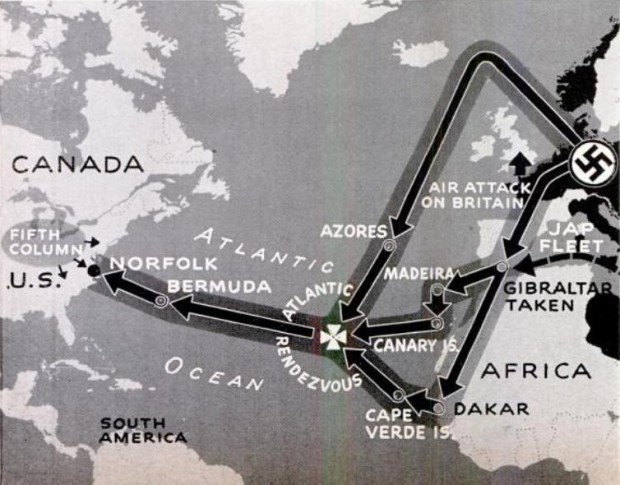Bermuda Factored In 1942 US Invasion Scenario
 A World War Two invasion of the US East Coast mounted and coordinated from an Axis base in Nazi-occupied Bermuda sounds like a scenario dreamed up by a science fiction writer — and it was.
A World War Two invasion of the US East Coast mounted and coordinated from an Axis base in Nazi-occupied Bermuda sounds like a scenario dreamed up by a science fiction writer — and it was.
But when “Life” magazine commissioned novelist Philip Wylie to come up with six variations based on the theme of an imminent German/Italian/Japanese attack on the United States, he was drawing on genuine military concerns then prevalent in Washington DC rather than his impressively fertile imagination. In the weeks following the December 7, 1941 Japanese air attack on the US naval facilities at Hawaii’s Pearl Harbour, American nerves were on edge about a possible Axis assault on the mainland.
The surprise military strike on the headquarters of its Pacific Fleet drew the previously neutral United States into World War Two [1939-1945]; four days after the Hawaiian naval base was crippled by two waves of carrier-based fighters, bombers and torpedo planes, Japan’s allies — Nazi Germany led by dictator Adolf Hitler [pictured above] and Benito Mussolini’s Fascist Italy — also declared war on the US.
The Axis grew out of the Anti-Comintern Pact, an anti-communist treaty signed by Nazi Germany and Japan in 1936. Italy joined the Pact in 1937. The “Rome-Berlin-Tokyo Axis” became a military alliance in 1939 leading to the integration of the military aims of Germany and its two treaty-bound allies.
In early 1942 “Life” — then one of the highest circulation news magazines in the US — approached Mr. Wylie, a “peacetime novelist, who later joined the Office of Facts and Figures in Washington”, as a sort of devil’s advocate to produce a series of speculative enemy invasion plans for the United States.
“When people say the US can lose the war, what they really mean is that some combination of the plans mapped here may work successfully for the Axis,” said the magazine. “Such an outcome, of course, presupposed that the enemy has nothing but good luck and the Allies nothing but bad luck
“… All that is set forth here is military logic and supposition, based upon the enemy’s past performance. Nor is any attempt made in these maps to indicate the American defense against the attack depicted, because such matters are, of course, profound military secrets. But reader may rest assured that the US Army and Navy are thoroughly familiar with the possibilities here outlined and will exert themselves to the limit to prevent them from happening.”
While most of the invasion scenarios devised by Mr. Wylie involved two-pronged attacks on the US launched along the Pacific and Atlantic coasts simultaneously, one posited a single-front transatlantic invasion involving the combined German, Japanese and Italian fleets as well as ships captured from the French after Paris fell to the Nazis in 1940.
“Combined Axis navies [seize] Atlantic islands, then take big water jumps from Azores to Bermuda to Norfolk,” theorised Mr. Wylie. “Their biggest headache is reported US superiority in carriers. Twenty-five Nazi ships could transport four divisions to possible landings along New Jersey, the Delmarva Peninsula, and North Carolina.”
Bermuda had entered into US strategic thinking even before the country became embroiled in World War Two. While still neutral, the US had begun construction of military fortifications in Bermuda in 1941, principally at the East End, to deter a German invasion of the island and to allow for the redeployment of British forces involved in Bermuda’s defence to more active military theatres of operation.
But in early 1942 the totalitarian Axis powers were as close as they ever came to achieving their objective for world domination. The Germans were in control of Austria, Czechoslovakia. Poland, Denmark, Belgium, the Netherlands, Luxembourg, France, Norway, Yugoslavia, Finland, Greece, Lithuania, Latvia and Estonia as well as huge swathes of the Soviet Union and North Africa.
Meanwhile, Nazi ally Italy controlled Sicily, Ethiopia and Libya and the Japanese had annexed large areas of China, South-East Asia and Indonesia.
A combined Axis assault on the US early that year was not ruled out by Allied military planners.
As Mr. Wylie said: “First principle of war is to knock out one enemy at a time. Our enemies are today pondering which nation to knock out in 1942. Usually the best enemy to attack is the one whose fall will tumble down all the rest. If the enemy is also at the moment the weakest in weapons, attack is all the more attractive. The Axis cannot end the war by knocking out England or Russia in 1942, and by 1943 the US may have so increased its fighting power that it will thereafter win the final victory. But if the US is conquered in 1942, when it is still assembling its great war machine, its fall automatically means that England and Russia are fighting without hope of further supply from the Arsenal of Democracy.
“In warfare, as in science, it is mandatory to make working assumptions. The enemy’s plans are no less heavily guarded secrets than our own. Therefore the game of war starts with the assumption that he has everything we know he has, plus a lot more. The Japanese Fleet, for example, is undoubtedly larger and stronger by two or three modern battleships [than America's]. To this fleet, for the purposes of invading the US, must be added some German naval strength — possibly the “Tirpitz” now and the “Scharnhorst”, “Gneisenau” and an aircraft carrier or two later — to give it an overwhelming superiority which is the first requisite for this kind of attack.
” …The Germans could there gain the same kind of superiority for a US invasion, if they could get their hands quickly on the [French] fleet, combine it with the Italian, receive strong support from the Japanese Fleet by the Indian Ocean and then taking Gibraltar, burst out into the Atlantic in full force …”
The breathless “Life” caption on the illustration accompanying Mr. Wylie’s scenario about an Axis invasion involving Bermuda [reproduced below] read: “An East Coast airport is here shown as it might have looked being captured by German landing forces who have been ferried by air transport from Bermuda following its capture by the Axis navies ..”
A combined Axis knock-out blow against the US never came to pass. By the end of 1942 the overextended Germans had become bogged down in the Soviet Union and were in full retreat in North Africa. Meanwhile a major US counter-offensive against the Japanese in the Pacific resulted in decisive naval victories at the Battles of the Coral Sea and Midway, ruling out even the theoretical possibility of Tokyo’s weakened fleet joining with German and Italian warships for an assault against America.
Writer Philip Wylie’ [1902-1971] was best known for works published in pulp science fiction magazines of the 1930s and ’40s. His 1930 serial “Gladiator” has long been considered one of the inspirations for the comic book character Superman, and his 1933 story “When Worlds Collide” was made into the 1951 movie of the same name.
He also wrote 69 “Crunch and Des” stories, most of which appeared in the “Saturday Evening Post”, about the adventures of two charter fishermen; these provided the basis of a brief television series shot in Bermuda in 1955.
Read More About
Comments (5)
Trackback URL | Comments RSS Feed
Articles that link to this one:
- Video: 1950s Bermuda TV, Film Studio | Bernews.com | March 11, 2013
- H.G. Wells: The War Of Words In Bermuda | Bernews.com | March 17, 2013




Hitler figured half a day to take over Bermuda.
It was to be a stepping stone for his forces to mount an attack on the USA.
Imagine Bermuda now IF this had happened.
Hitler didnt want to wait 3 months for a permit to invade !!!
No way those Germans could get in here. Not one of them knows how to say “Good Morning”. The sucking of teeth at Immigration would have stunned them till the Yanks arrived.